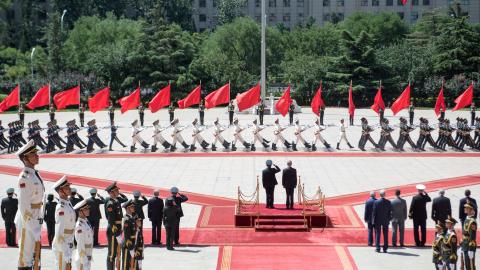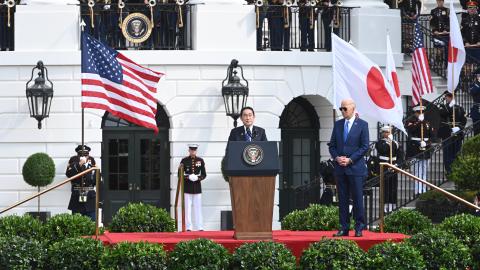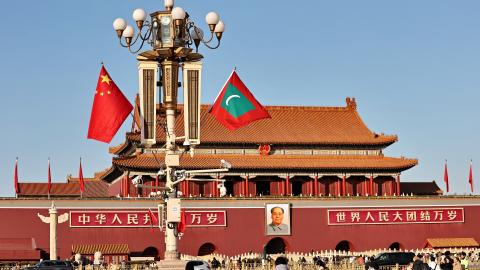President Mohamed Muizzu took office in the Maldives in November 2023. Muizzu is a pro-China, anti-India president who has promoted an “India Out” policy, calling for the withdrawal of Indian troops who had been stationed in the Maldives. He also allowed a Chinese military research vessel (which the Indian media referred to as a “spy ship”) to make a port call in February 2024, and in March received a Chinese military delegation and signed a memorandum of understanding (MoU). These developments mark another step forward in China’s growing presence in the Indian Ocean region.
China has become quite active in the Indian Ocean in recent times. It is thought to have dispatched a number of research vessels to the region for nautical charting to enable the deployment of Chinese submarines and to collect information about India’s experiments including the test of multi-warhead ballistic missiles. The Chinese military delegation that visited the Maldives also called on Sri Lanka and Nepal, concluding agreements on military cooperation with each of them.
China’s moves into the Indian Ocean region are part of a trend that has been steadily gathering momentum since the 2000s. To date, Beijing has deployed three approaches. The first is infrastructure construction. China’s infrastructure construction tends to involve loans extended at high rates. The World Bank and the Japan-led Asian Development Bank typically offer interest rates of 0.25-3 percent, while China lends at 6-8 percent. As a result, it is quite common for borrowers to end up with large amounts of debt that cannot be repaid, forcing transfers of infrastructure control to China.
China is also promoting arms exports to India’s neighbors. It supplies submarines to Bangladesh and Pakistan and frigates to Sri Lanka. Weapons are precision instruments, but because they are used in harsh environments, they are fragile and require repair and the supply of parts. Naturally, if you use Chinese-made weapons, you will become dependent on the supply of parts from China.
Meanwhile, China is deploying its own military to the Indian Ocean. In 2008, it dispatched warships to deal with piracy off the coast of Somalia and it has since been actively deployed to the Indian Ocean. In particular, China has sent submarines, which are a threat that can attack other countries’ sea lanes. China is planning to deploy more naval vessels centering on the base it has built in Djibouti.
Why Is China Expanding Into the Indian Ocean?
Looking at the positions where China is building infrastructure, it is not hard to understand Beijing’s interest in the Indian Ocean. China is building infrastructure along the routes that feed resources to its Pacific coast cities, Shanghai and Hong Kong, which it regards as exceedingly important. Looking at the locations of port construction in the Indian Ocean, we can see they are along routes like the Middle East–Indian Ocean–Pakistan–Xinjiang Uyghur Autonomous Region, or Middle East–Indian Ocean–Myanmar–China, or Middle East–Indian Ocean–Malaysia (Indian Ocean side–across the Malay Peninsula–South China Sea side of Malaysia)–Cambodia–China. As much as possible, China wants to avoid transporting energy resources from the Middle East through the Malacca Straits, where the United States and India can deploy their naval power. To that end, the Chinese are creating multiple alternative routes. However, many of these alternative routes pass through the Indian Ocean. For this reason, China seems to think that it needs to take its own measures to guarantee security in the Indian Ocean.
However, this is not the only reason for China’s growing presence in the Indian Ocean. Looking at past patterns, it is evident that Beijing seeks to take advantage of power vacuums. The South China Sea is a good example. In the 1950s, China occupied half of the Paracel Islands when French troops withdrew. In the 1970s, when U.S. troops withdrew, it occupied the other half. In the 1980s, as the Soviet troop presence in Vietnam dwindled, China captured six locations on the Spratly Islands. In the 1990s, when U.S. troops left the Philippines, it occupied Mischief Reef. In other words, whenever the military balance changes and a power vacuum is created, China tends to advance its positions, like water flowing into a gap.
The Indian Ocean was experiencing just this kind of power vacuum after the Cold War. The Soviet Union was gone, the United States did not attach great importance to the region, and India was still developing. In response, China stepped up its expansion.
How should the Quad respond to China? To counter China’s advances, it is important to avoid creating a power vacuum. However, Japan and the United States cannot afford to send many ships to the Indian Ocean. China has built and deployed 148 new warships in the past decade alone. That almost equals the total number of ships in the Japan Maritime Self-Defense Force. In total, the People’s Liberation Army Navy already has more ships than the U.S. Navy.
This is where India comes in. The Indian Navy is expanding rapidly. Currently, it has about 140 ships, but this is expected to be 170–175 ships by 2035. It is also very active. In a recent case of Yemen’s Houthis attacking vessels navigating in the Red Sea, India dispatched more than 10 vessels to rescue ships at various locations. For Japan and the United States, cooperation with India offers new hope.
Until now, the Indian military has had only weak anti-submarine capabilities. As China continues to deploy submarines, Japan, the United States, and Australia will need to work together to enhance India’s anti-submarine capabilities and create an anti-submarine information sharing system that can be used in real time within the Quad.














